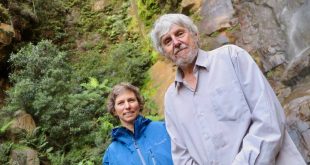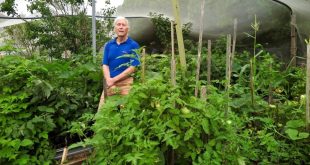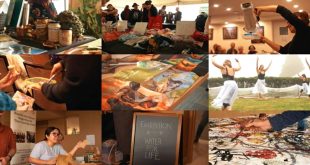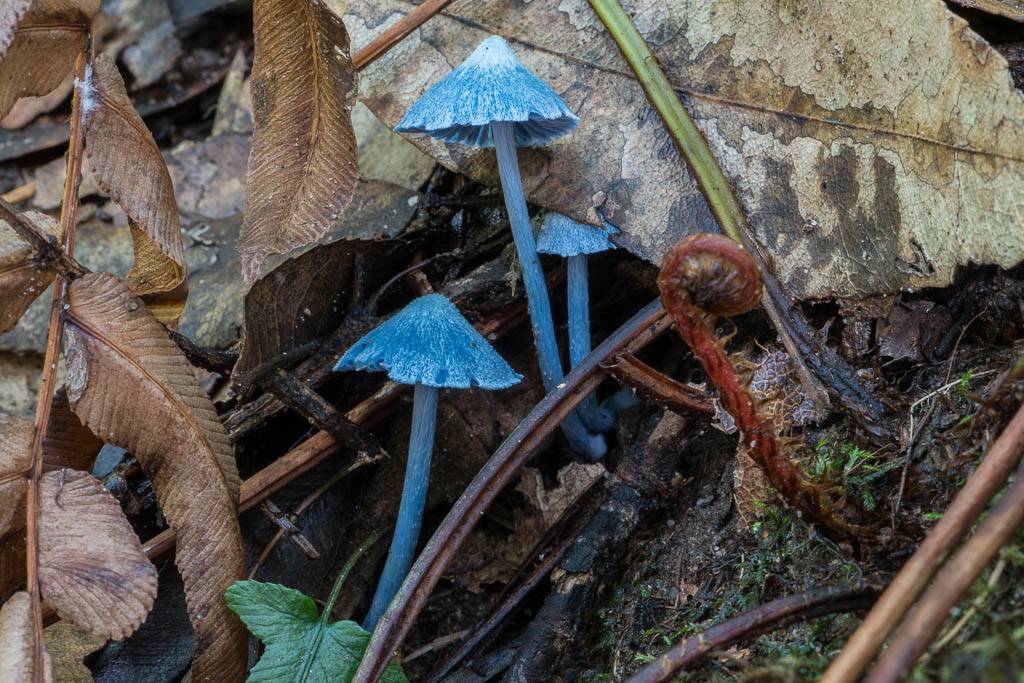
Stuff of the fairies. ‘Inocephalus virescens group’ caught by the lens of David Noble on the Leura to Katoomba Waterfall Walk. (Photo: David Noble)
Story by Linda Moon
Maligned through the ages for their association with witchcraft, disease, drug use and poisonings, the fungus kingdom is gaining due credit thanks to ecologists, photographers and foragers.
Key Points:
- With its diverse ecosystems, the Blue Mountains, and Australia more generally, is a hotspot for fungus species.
- The vast, hidden kingdom of the underground mycelium network plays a central role in soil health, recycling and sustaining life on the planet.
- Fungi can play a role in mediating the effects of climate change, bushfires and pollutants. Helping fungi helps us.
It’s mushroom season again. For a short spell, mushie workshops, tours and outings are popping up on social calendars.
In reality, the fungal network (the mycelium) persists year round. Composed of a subterranean web of tiny, spreading filaments, it quietly continues performing a job pivotal to life on the planet.
The bush carer
The mushrooms we see popping up almost magically are just the fruiting body of fungi, explains Steven Fleischmann, a Bushcare Officer for Blue Mountains City Council and a Landcare Coordinator in Lithgow. “Autumn, with rain and cooler temperatures, is when the mushroom season kicks off. That’s when they have their sexual fruiting. Unlike a flower it doesn’t have pollen, it has spores,” he says.
Steven first became captivated with fungi as a teenager in the 80s. “I used to buy mushroom kits and grow them. One of the first things I learned to cook was mushroom soup. It started as a culinary thing.” His interests in ecology, land management and growing food continued to fuel the passion. “Just doing the work I do in the bushland areas [his job takes him between Glenbrook to Oberon] you see fungi everywhere.”
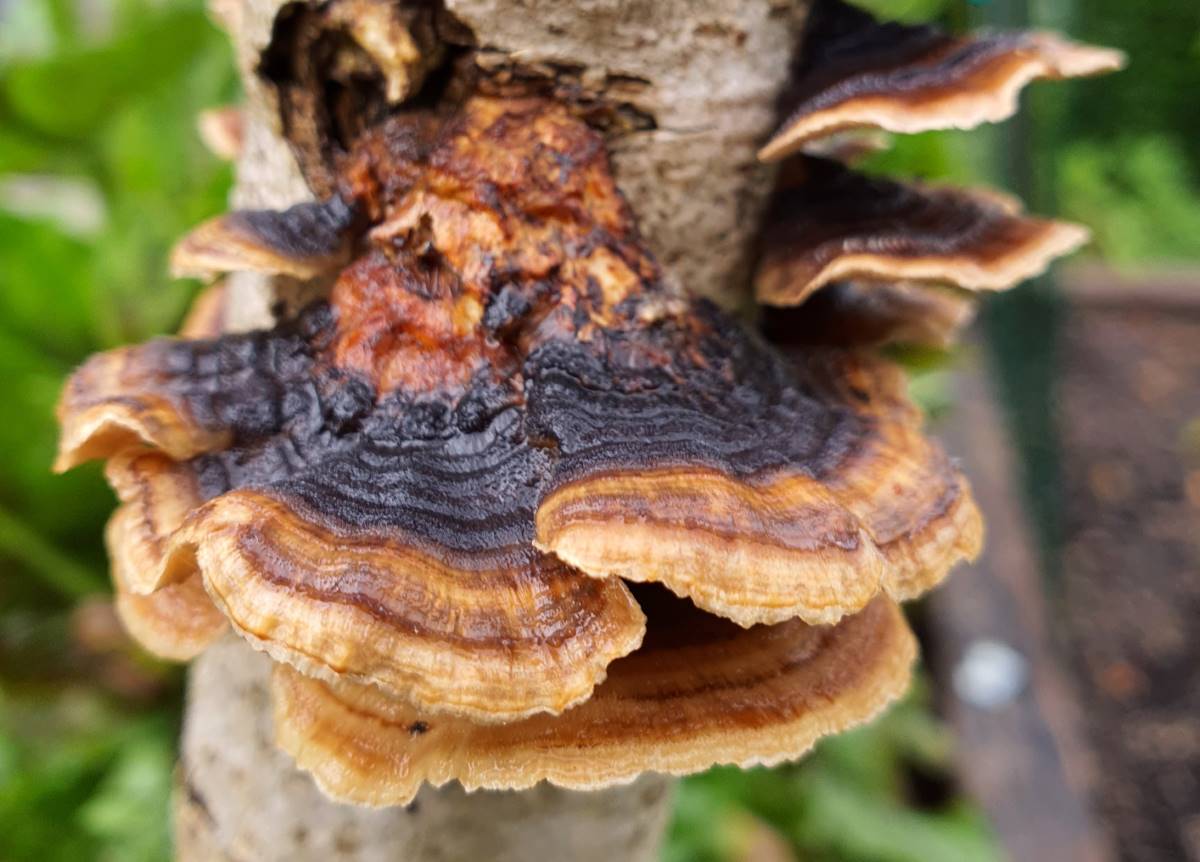
Trametes, a common bracket fungi, in a Katoomba garden. Turkey Tail (Trametes versicolor) is used as a cancer treatment in Japan. (Photo: Linda Moon)
He says russulas, native milk caps and bracket fungi are particularly common. The latter exist on dead wood or the dead parts of trees, he says.
“It’s a fascinating field, but an enormously understudied, under appreciated – at a scientific level – and underfunded field of study,” Steven says.
Steven’s fungus fetish – shared by partner and veterinarian Gemma Williams – has evolved into them running mycology workshops. Gemma, who is also a sleuth at identification, has hundreds of stunning pictures of fungi on her Instagram account: missaudreysadventures.
The photographer
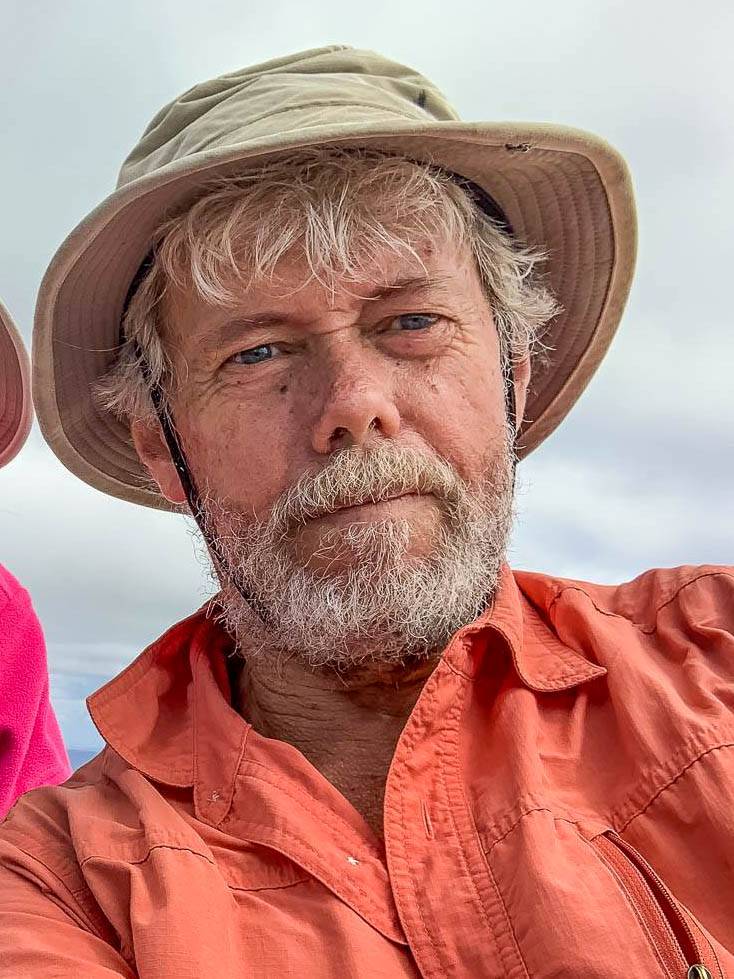
David Noble: “I find the whole fungi kingdom fascinating.” (Photo: David Noble)
Another contributing to fungus awareness and appreciation is David Noble. Legendary for his blogs and photographs of the Blue Mountains and beyond, he’s been photographing fungi for over ten years. In his nature forays into the Blue Mountains he’s come across scores of fungus species, including potentially new and undescribed species.
“A few days after a good fall of rain, it you walked from the bottom of Leura Falls through Leura Forest and then around to the base of the Scenic Railway, you could expect to find anything from 20 to 50 species,” he says.
The former science teacher took up an interest in fungi after retirement. “I had good friends that worked as botanists and ecologists, but none of my friends knew much about fungi, so I thought it would be a good kingdom to explore.”
“The bizarre forms that fungi exhibit are really amazing,” he enthuses. “From the conventional mushroom to Boletes with their pores and colour changes, fungi that looks like coral, fungi with spines, Jelly Fungi, the Cordyceps that grow off insects, fungi that has a trumpet shape – it goes on and on.”
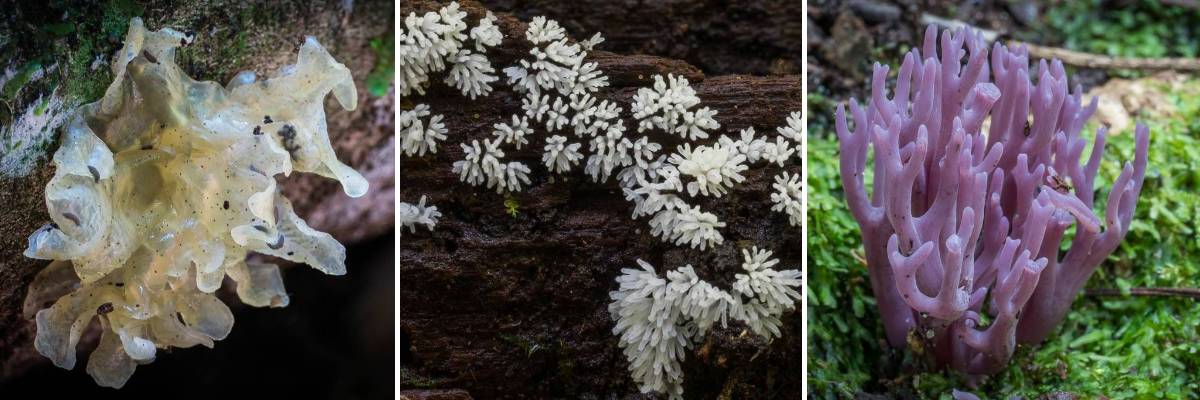
The many shapes of fungi. Jelly Fungus (Tremella sp) and Slime Mould (Ceratiomyxa fruticulosa) snapped at Leura Forest and Clavaria zollingeri at Blackheath. (Photos: David Noble)
His favourite are a group known as “waxcaps”. Small and colourful, they may be green, red, yellow or blue.
He urges people to look at the ground in the leaf litter when in rainforest gullies in the Blue Mountains after rain. There you may find a strange fungus known as Dead Man’s Fingers. Shaped like small black clubs, they’re often seen coming out of rotten logs.

Fungi fever. Various colours of Waxcaps at Coachwood Glen, Blackheath. “Some of the species in the group are very common, but some are very rare and you may only find them once every few years,” David says. (Photos: David Noble)
Becoming a member of the Sydney Fungal Studies Group Inc has taught him a lot. The group was started by academics with expertise in mycology to further knowledge in the subject. During mushroom season they run field studies in the Upper Blue Mountains.
The mycologist
According to mycologist and author, Alison Pouliot, fungi have colonised pretty much every terrestrial and aquatic habitat on earth. But generally they prefer undisturbed habitats with large amounts of organic matter (fungus food) of different species, sizes, shapes and ages. “The more diverse the habitat the greater the diversity of fungi,” she says.
While the Blue Mountains hosts a wide variety of fungi, because they’re poorly surveyed no one knows exactly how many species exist here. In fact, the majority of fungi across Australia are yet to be named or discovered, Alison says.
According to DCCEEW (the Department of Climate Change, Energy, the Environment and Water) there’s an estimated 160,000 to 250,000 species of fungi in Australia. A largely undiscovered realm, less than five per cent have been described.
Interestingly, the nation is one of 18 countries considered to be ‘megadiverse’ in terms of fungi, Alison says.
“Fungi have largely been overshadowed by flora and fauna. We often only become aware of them when they produce mushrooms. So they’re not in our consciousness as much as animals and plants.” – Alison Pouliot.
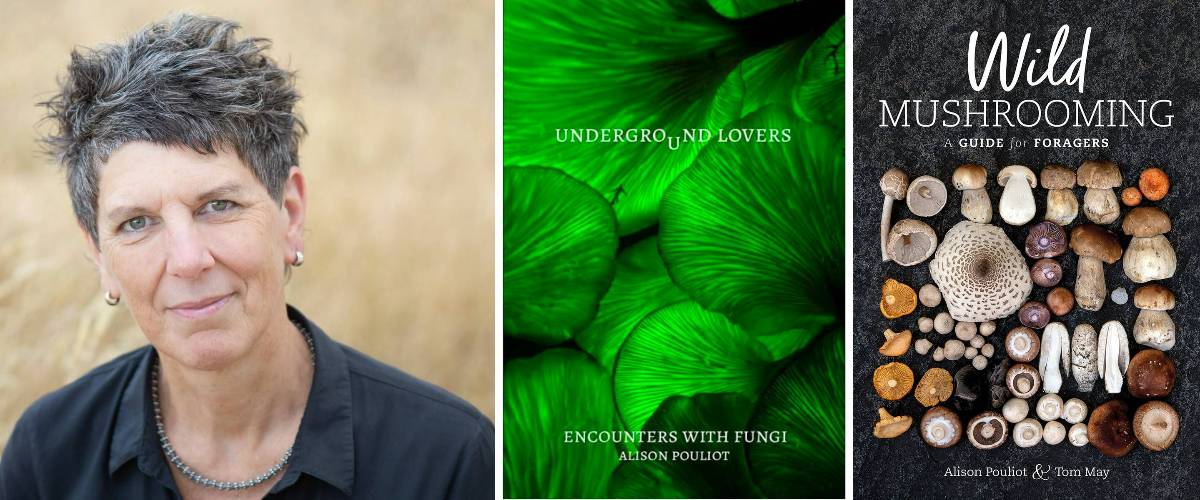
Mycologist Alison Pouliot has authored multiple books on fungi, including ‘Underground Lovers’ and ‘Wild Mushrooming’. (Photo: Valérie Chételat).
Fantastic facts about fungi
Fungi share characteristics of both plants and animals, but are neither, Alison says. The kingdom of fungi includes moulds, yeasts, rusts and lichens.
“They’re primary recyclers of organic matter, unlocking nutrients and releasing them for plants,” Alison says. “They support soils by putting in architecture, aerating them and filtering water. They connect up plants, helping them access nutrients and water.” Like a “connective tissue that underpins terrestrial ecosystems”, they’re vitally important, she says.
Fungi are ‘heterotrophs’ like us, Steven says. “They take food and consume it.” Like a huge underground gut, one of their key roles is to break down and decompose things (including wood) making nutrients available for themselves and plants. Plants are autotrophs, meaning they use food to produce energy.
Remarkably, the underground network of mycelium can cover many square kilometres. In fact, the largest organism in the world is a fungus. The “Humongous Fungus” – as it’s nicknamed – is a species of honey mushroom in Oregon spanning 9 square kilometres. Scientists estimate it’s over 2,400 years old.
Helping the planet, some fungi store carbon in the soil; others have been found to break down soil toxins including heavy metals, plastics, petrochemicals, oil and even radioactive materials.
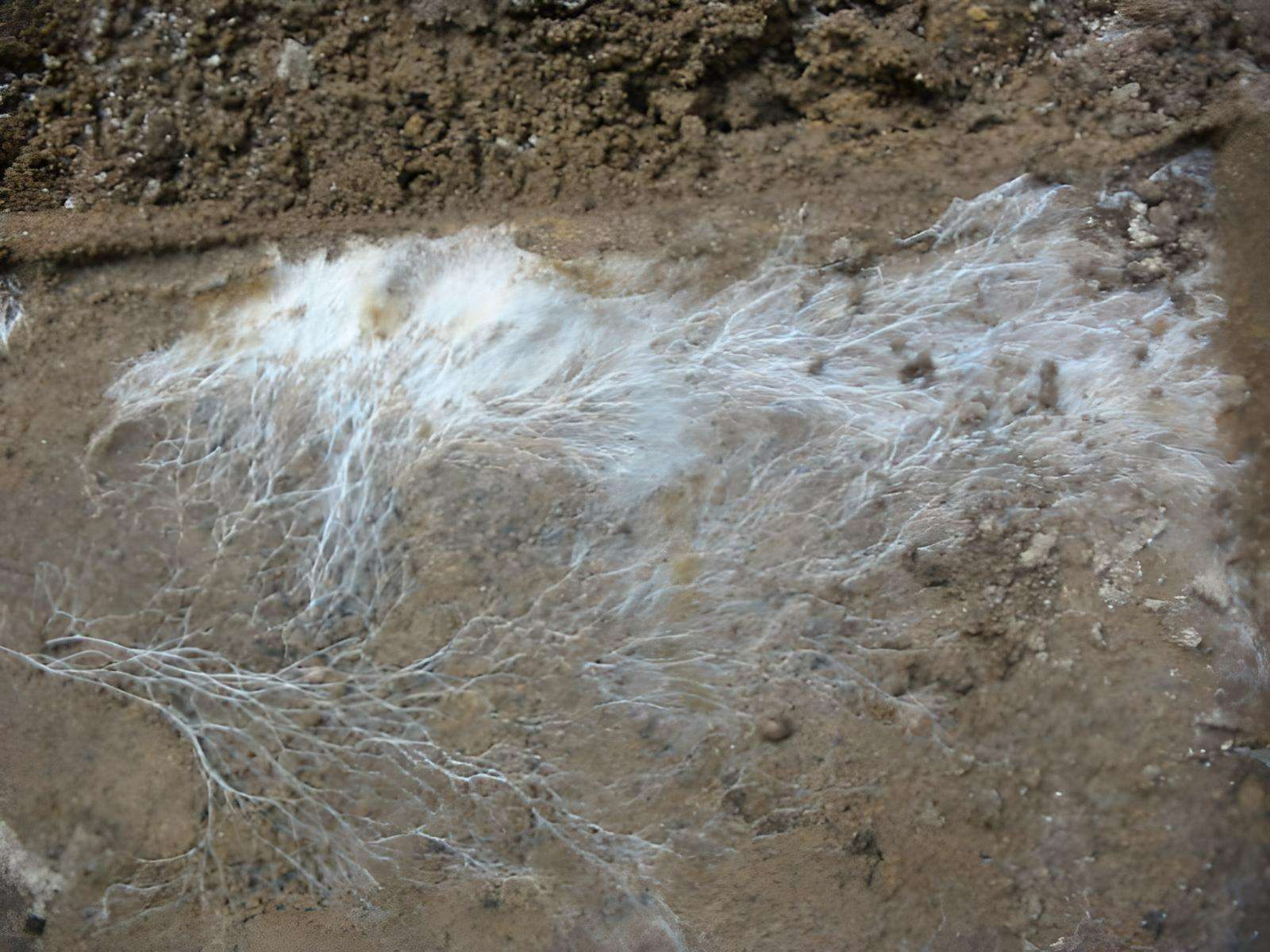
The mycelium – connective tissue of soil. (Photo: Lex en ik woon, Wikimedia. Image licensed under the Creative Commons Attribution-Share Alike 3.0 Unported license.)
How fungi help heal the landscape after bushfires
Fungi play a role in succession and rebuilding of the landscape after a bushfire. Pyronema species colonise alkaline ash beds after fire, paving the way for larger macrofungi like Leathery Sawgills which fruit off buried wood, Gemma says. The fungi provide emerging plant seedlings with the nitrogen, minerals and water they require. After the recent bushfires, Gemma and Steven discovered scores of Leathery Sawgill.
“When there’s a disturbance, certain species will come up and they have a job or niche, and then they’ll do their thing – that could be anything from holding soil so it doesn’t wash away to changing soil pH.”
![Leathery Sawgills [Neolentinus dactyloides]](https://www.katoombalocalnews.com/wp-content/uploads/2024/04/leathery-sawgills.jpg)
Leathery Sawgills [Neolentinus dactyloides] rising out of burnt soil affected by the 2020 fires are powerful healers of the forest. (Photos: Gemma Williams)
Fungus conservation
Theoretically, fungi can live indefinitely as long as they have a food source. However, few get the opportunity, Alison says. Agriculture, forestry and land development disturbs their habitats and robs them of food. Other threats to fungi include invasive species, climate change, pollutants and agrochemicals like pesticides, fungicides and herbicides.
“They need to be recognised as a part of biodiversity and included in conservation initiatives,” Alison says. “For example, we know of several dozen native mammals that feed on fungi. There’s no point in protecting the mammals if we don’t protect their food source, too.”
“It’s taken a long time for people to recognise their great ecological significance, but on a positive note, things are changing rapidly as people recognise what important and amazing organisms they are.”
In 2020, Chile became the world’s first country to incorporate mushrooms into environmental legislation, thanks to the work of the Fungi Foundation.
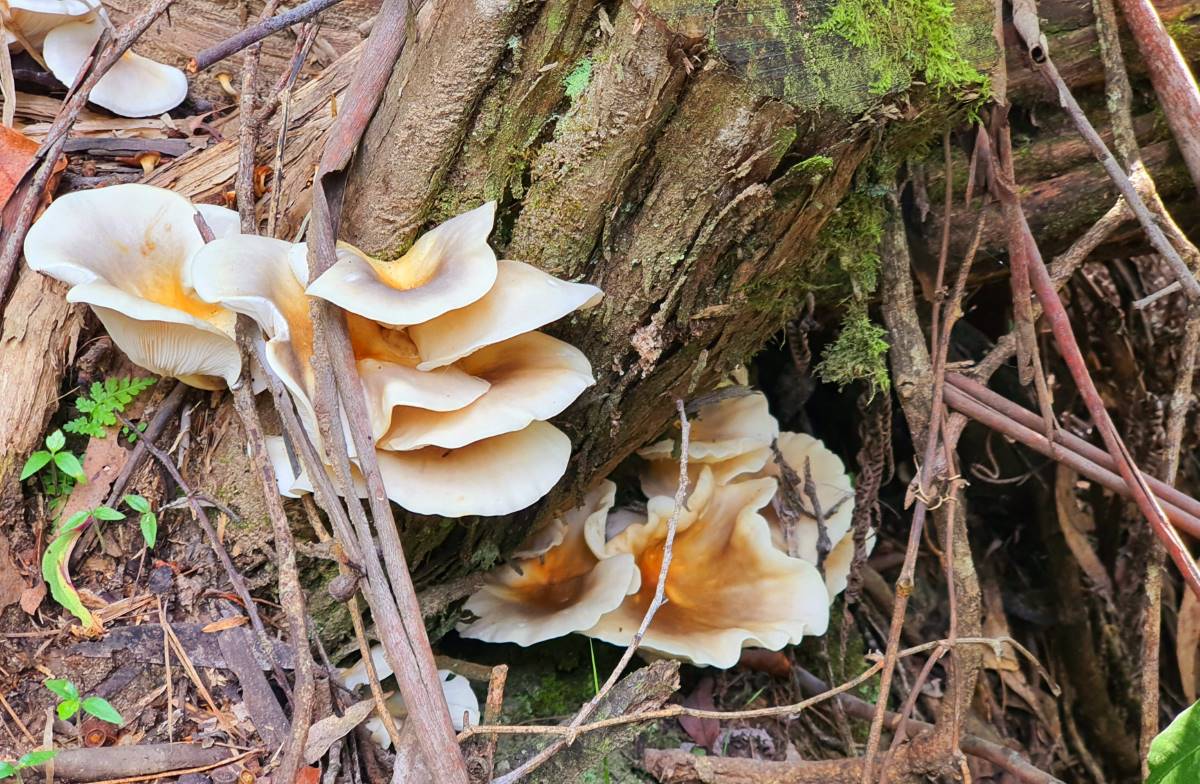
Undisturbed bioluminescent, glow-in-the-dark fungus, Ompholatus nidiformis, thriving on a tourist walk in the Katoomba Falls area. (Photo: Linda Moon)
Foraging edible fungi
Legally speaking, it’s fine to collect ‘exotic’ species of mushroom, Steven says. The Saffron Milk Caps and Slippery Jacks commonly sought after by foragers are introduced varieties associated with pine trees. Where something is in the landscape is a super important part of fungi ID, Steven emphasises.
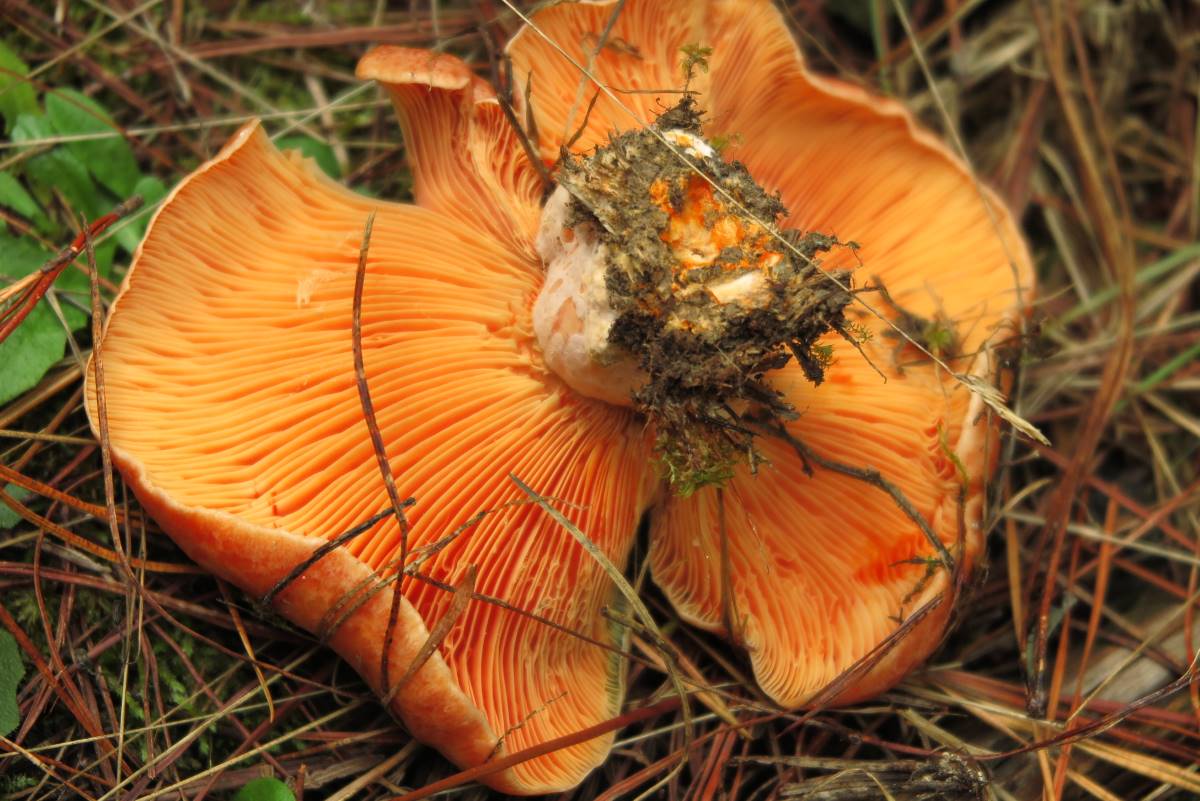
The Saffron milk cap – popular with mushroomers and found under pine trees in the Blue Mountains and elsewhere. (Photo: Linda Moon)
When in doubt, do without. Or take an expert with you.
“Interestingly, there’s only one test for edibility,” Steven says. “And if you get it wrong, which is entirely possible and easy to do, it can have quite a catastrophic outcome.”
Alison agrees. “We’re yet to name most fungi let alone know which are edible and toxic”.
There are several ‘native’ edible mushrooms in the Blue Mountains. “They were a food source for Aboriginal people,” Steven says.
Biodiversity laws protect native fungi, meaning you can’t pick them, he says. Mycologists have to have a scientific license to collect them.
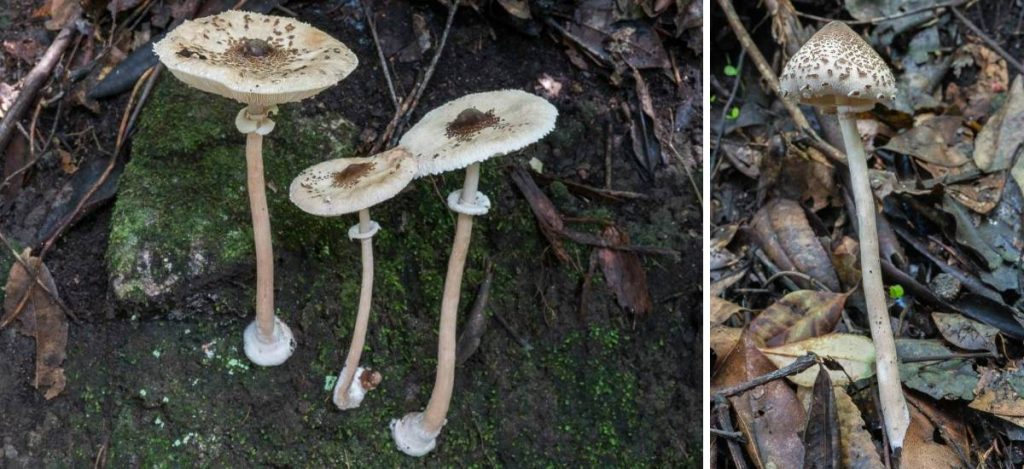
Native edible mushie, Macrolepiota clelandii (the Australian Parasol) thrives in Eucalypt forests but has many toxic lookalikes, Alison says. (Photos: David Noble)
Fungi in the garden
Should we welcome the fungi that pop up mysteriously in our gardens?
It’s complex. Some fungus species are pathogenic, Steven reminds. These include Armillaria (the Honey Fungus).
Generally speaking though, “fungi are an indication that soils are intact and there’s organic matter to feed on,” Alison says. “If there are no fungi appearing, then there’s a reason to worry about the health of your garden.”
All fungi need nice, soft, healthy soil, Steven says. “One of the worst things that can happen to soil is to be compacted.” The tiny mycelium tubes (the hyphae), that transport nutrients and water to plants are only a few microns thick, he says. “You can see them when you dig in the soil and find all those little white threads that look like spider webs.” These wend their way in between soil and its components, the broken down pieces of rock, rotting leaves and bits of sticks, looking for what the organism needs – whether it’s water or a piece of wood, and it starts to decompose it.
“Underneath your feet, is a really complex relationship between living and non-living elements” – Steven Fleischmann.
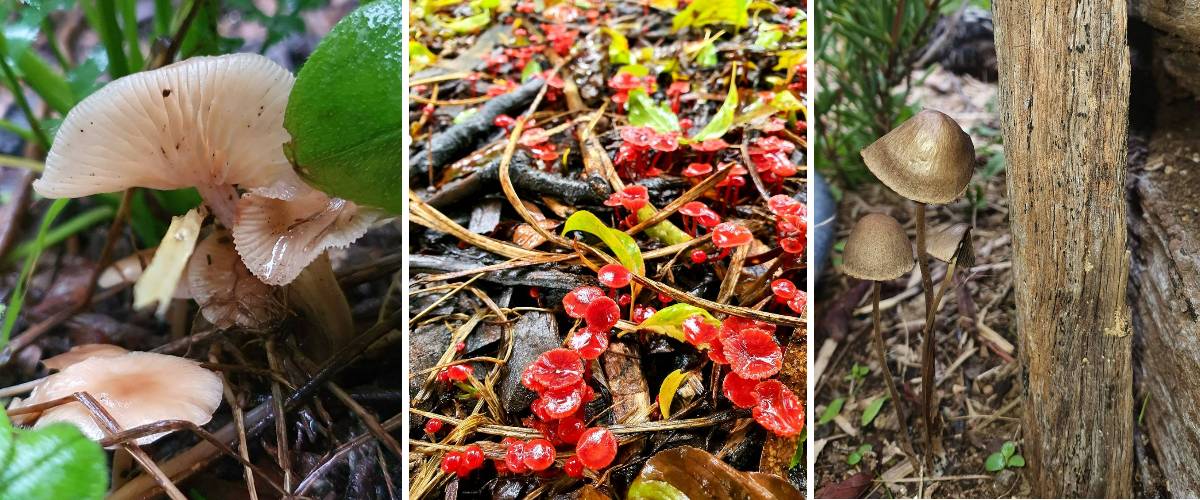
Various fungi cropping up in a small Katoomba garden after autumn rain. Sign of a healthy soil. (Photo: Linda Moon)
Take Action:
- Attend a free Lithgow workshop (it will feature a talk by a mycologist and a demonstration of how to grow oyster mushrooms as part of Mycology May – a month of workshops and talks across the Central Tablelands).
- Watch Fantastic Fungi, the mushroom doco people are raving about. It’s on Netflix.
- Join your local Bushcare group.
- Avoid compacting your soil and add lots of organic matter to it.
- Avoid picking or damaging mushrooms in the wild.
- Teach others to value fungi.
- Contribute to and learn from citizen nature ID and conservation sites including iNaturalist and Fungimap.
- Lobby governments to stop clearing native vegetation.
Share this article:
This story has been produced as part of a Bioregional Collaboration for Planetary Health and is supported by the Disaster Risk Reduction Fund (DRRF). The DRRF is jointly funded by the Australian and New South Wales governments.
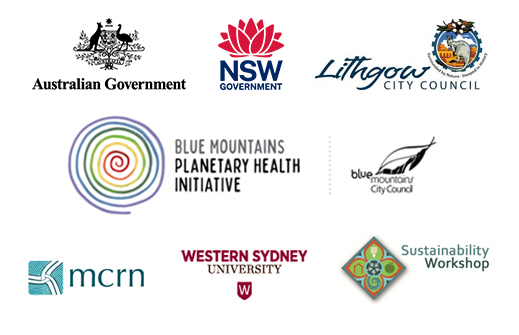
More from around the region
Find out how you can join our team of writers and videographers next Saturday 25 May! Our stories drive and transform our culture. Over the last 15 months we’ve hired staff, run workshops and mentoring programs for aspiring writers and videographers, and welcomed volunteers to our team, so we can find and share the solutions we need. If, as communities, we work together to support one another and to share better ways of doing things, future extreme weather events are less likely to become disasters and we’ll have the capacity to do what needs to be done to restore the health of our planet so that all life can flourish. Would you like to join our fabulous and growing team! Next Saturday evening at 7pm we’re launching the Planetary Health Writers’ Network, following a workshop with award-winning writer Sophie Cousins from 2-5pm. Join us! All ages welcome. Registration essential for the workshop here (link in profile): https://bit.ly/3V6kQke and for the Writers’ Network here (link in profile): https://bit.ly/4dLOthL
Both events are free thanks to funding from Disaster Risk Reduction Fund (DRRF). The DRRF is jointly funded by the Australian and New South Wales governments.
#changethestory #solutionsmedia #togetherwecan #writers #videographers #creativesforclimate #planetaryhealth #katoomba #bluemountains #collaboration #writersnetwork
In April 2021 Blue Mountains City Council became the first Council and government entity in Australia to commit to integrating Rights of Nature (RON) principles into its operations and practices. Yesterday we were thrilled to be able to spend a few hours with Susie Talbot, an Australian lawyer, based in the UK, who was visiting on a Churchill Fellowship to explore the implementation of Rights of Nature in different parts of the world. It was inspiring to hear how she has spent decades using the law to achieve transformative change in relation to complex socio-economic and environmental challenges. In 2020, she founded the Anima Mundi Law Initiative to strengthen the intersections between human rights and ecology, and to encourage the practice of law in alignment with planetary realities and collective consciousness. Projects include the creation of a ‘Rights of Nature Toolkit’ and we look forward to working with her into the future. You can read more at her website: https://www.animamundilaw.org/
Photo: Susie Talbot standing in front of Scott Marr`s artwork in the Planetary Health Exhibition space.
#rightsofnature #earthjurisprudence #anewlegalstoryforanecologicalage #ecologicalage #churchillfellowship @churchillfellowship #animamundi #humanrights #ecology #planetaryhealth
Nelson Mandela once said “Education is the most powerful weapon which you can use to change the world”; and William Butler Yeats, the great poet, said “Education is not the filling of a pail but the lighting of a fire.” If you’re a teacher, educator or involved in education in some way in the Blue Mountains the staff of the Blue Mountains Planetary Health Initiative would love to meet you next Monday 20th May when we join the Blue Mountains Sustainable Schools Network to see how we can all join forces to urgently accelerate the change we need to restore the health of our planet. 3.30-5.30 at Faulconbridge Public School. RSVP Beth Healy DirtMum (details in poster)
#sustainableschoolsnetwork #collaboration #planetaryhealth #environmentaleducators #artteachers #englishteachers #musicteachers #allteachers
Hans and Tillie Coster have brought a Tolkien fantasy to life, building an underground Hobbit Hall at their property ‘Middle Earth’ in the Kanimbla Valley. They`ve come very close to self-sufficiency, storing their solar power in banks of nickel-iron batteries, and building underground has meant they`re more able to withstand extreme weather events. They`ve also reforested degraded country, planting over 3000 trees! Read more in Lithgow Area Local News (link in profile):
https://lithgowlocalnews.com/middle-earth-kanimbla-valley/
#middleearth #hobbiton #hobbithall #kanimblavalley #selfsufficient #offgrid #nickeliron #solarbatteries #nickelironbatteries #reforestation #undergroundhouse #compostingtoilet #disasterriskreduction #planetaryhealth
There are only about 750 Dwarf Mountain Pine plants left in the wild, according to the latest survey. The survivors are limited to waterfall spray and seepage zones in the southern escarpment between Katoomba and Wentworth Falls, but renewed efforts to save it in light of its potential upgrade to ‘critically endangered’ status are giving greater recognition to a rare and unusual prehistoric native in our midst. Read more in Katoomba Area Local News (link in profile)
https://www.katoombalocalnews.com/saving-the-dwarf-mountain-pine/
#dwarfmountainpine #criticallyendangeredspecies #prehistoricnative #biodiversity #collaboration #whatwecando #katoomba #wentworthfalls #bluemountains #planetaryhealth
Our Planetary Health newsletter is now out, sharing inspiring stories from the Lower Mountains to Lithgow: Read it here and subscribe via any of the Local News sites: https://bit.ly/3QKevs6 (link in profile)
Katoomba Area Local News: Living on the Ledge: Saving the Dwarf Mountain Pine
Lithgow Local News: How a Tolkien Fantasy Turned Into Off-grid Reality at Middle-Earth in the Kanimbla Valley
Blackheath Area Local News: Inspirational, Intergenerational Play in Blackheath
Lower Mountains Local News: The Positive Social Impact of the Glenbrook Country Women’s Association
Mid Mountains Local News: Stronger Together: Mid Mountains Neighbourhood Centre Walks the Talk
Springwood Area Local News: People Of Binfluence: The 2024 Binfluencer Awards
#solutionsmedia #hyperlocalnews #planetaryhealth #localstories #inspiration #bluemountains #lithgow
Woohoo we just hit 1 MILLION views on our reel about Physicist Hans Coster and why he`s using nickel-iron batteries.
You can now read the full story and watch a video about him and his wife Tillie at their property Middle Earth (links in profile). We`d love you to subscribe to our Blue Mountains Planetary Health YouTube channel and share the latest video on him there as well.
The video is fabulous:
https://www.youtube.com/watch?v=3kqAczIRzqk&t=17s
#offgrid #underground #nickelironbatteries #planetaryhealth #reforestation #selfsufficient #middleearth #bagshotrow
A small group of Blue Mountains women is helping local women survive and thrive and also contributing to improve maternal and newborn survival in developing countries. Assembling birthing kits for women in remote locations is just one of the many ways the @zontaclubbluemountains is empowering and supporting women, both abroad and at home. Read more in Lower Mountains Local News (link in profile)
https://lowermtnslocalnews.com/zonta-blue-mountains/
#womensupportingwomen #maternalhealth #birthingkits #zontainternational #zonta #abetterworldforwomen #localaction #localactionglobalimpact #planetaryhealth
We are thrilled to announce that award-winning health writer and author Sophie Cousins will be leading the workshop: Our Community, Our Stories: Writing for Change from 2-5pm on Saturday 25 May at the Planetary Health Precinct. Sophie`s work has been published in the New York Times, London Review of Books, the Guardian, the Lancet, Meanjin and others. She also works as a public health consultant for the World Health Organisation. The workshop will be followed at 7pm by the launch of the Planetary Health Writers Network. Places are limited so bookings essential (link in profile): https://www.eventbrite.com.au/e/our-community-our-stories-writing-for-change-tickets-895548458547
#writingforchange #impactfulstories #solutionsjournalism #writingworkshop #planetaryhealth #changethestory #thenewsweneed #writersnetwork #bluemountains #katoomba
We`re thrilled to welcome Tamsyn McGrouther to our growing team of volunteer storytellers. She`s reporting on how the Springwood Lot Party transformed an underused space, the car park at Springwood Train Station, into a vibrant community space with food stalls, art opportunities and live music. Read more in Springwood Area Local News (link in profile) : https://springwoodlocalnews.com/springwood-lot-party-2024/
#changethestory #hyperlocalmedia #solutionsmedia #springwood #inspiringstories #planetaryhealth #bluemountains #localnewsmatters
What do tea, samurai clans, William McArthur, Benjamin Franklin, Vietnam and the Botanic Gardens at Mount Tomah have in common? Read our story in Blackheath Area Local News to explore the way camellias and cultures are woven together and why it’s important we think about conserving biodiversity as a global project implemented at a local level. (link in profile) https://blackheathnews.com/camellias-at-blue-mountains-botanical-garden/
@botanicsydney #botanicgardens #mountomahbotanicgardens #camellias #camelliasinensis #tea #samurai #bluemountains #themounts #biodiversity #planetaryhealth
Mushrooms are a hot topic at the moment with more and more research illuminating the essential role these organisms play in the health of the planet as well as the significant health and medicinal benefits they hold for humans. Belle Butler visited local mushroom grower, Alex Felix, at his farm in Lawson to talk about the mighty mushroom. Read more in Mid Mountains Local News (link in profile)
https://www.midmtnslocalnews.com/earthrising-mushroom-farm/
#mushroomgrowkit #mushrooms #fungi #growyourown #lawson #bluemountains


